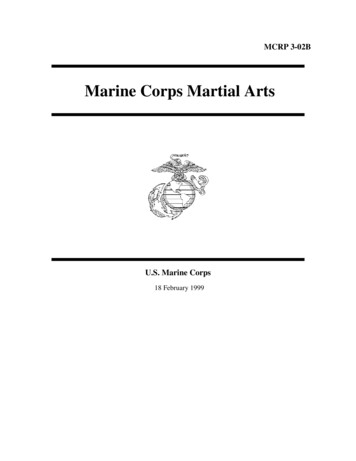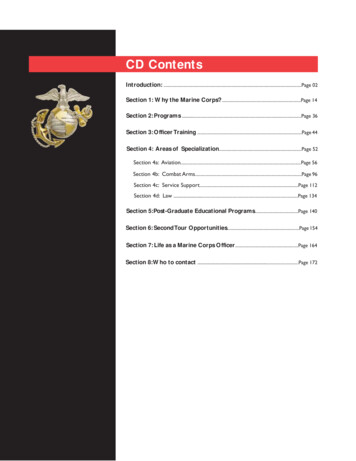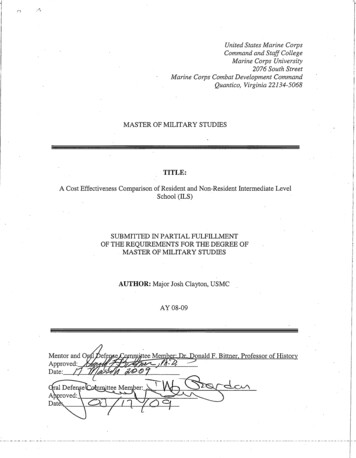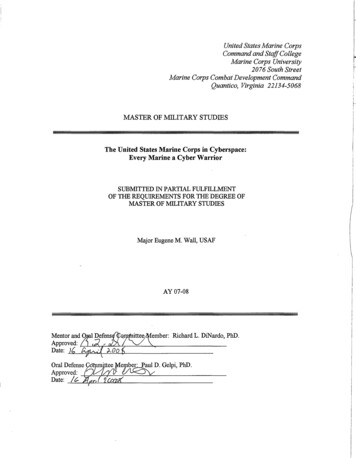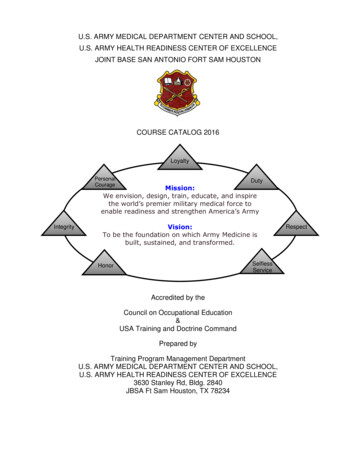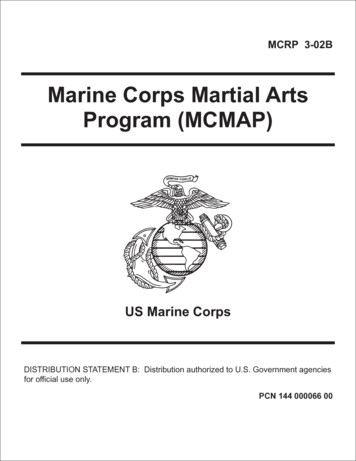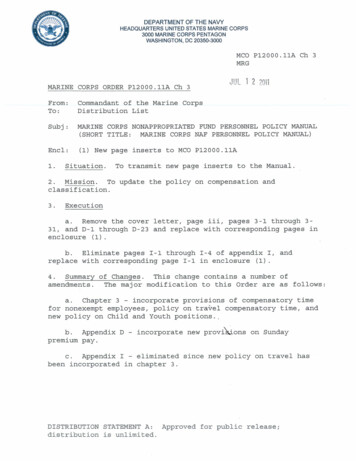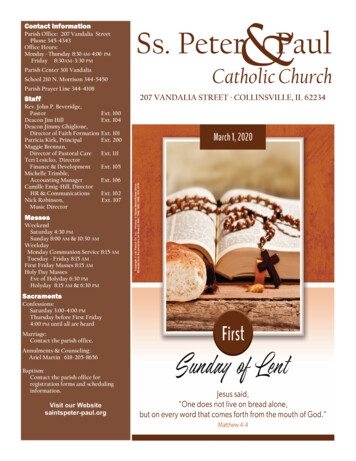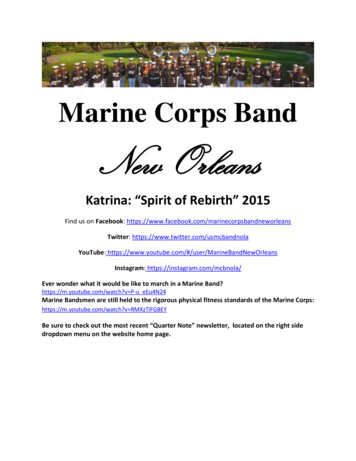
Transcription
Marine Corps BandNew OrleansKatrina: “Spirit of Rebirth” 2015Find us on Facebook: Twitter: https://www.twitter.com/usmcbandnolaYouTube: sInstagram: https://instagram.com/mcbnola/Ever wonder what it would be like to march in a Marine Band?https://m.youtube.com/watch?v P-u eEu4N24Marine Bandsmen are still held to the rigorous physical fitness standards of the Marine Corps:https://m.youtube.com/watch?v RMXzTlFGBEYBe sure to check out the most recent “Quarter Note” newsletter, located on the right sidedropdown menu on the website home page.
Officer in Charge/Principal Conductor Biography:Chief Warrant Officer 3, Michael J. SmithChief Warrant Officer 3, Michael J. Smith, originally from Terre Haute, Indiana,enlisted in the Marine Corps in 1987. Upon completing Recruit Training atMarine Corps Recruit Depot San Diego, he was meritoriously promoted toPrivate First Class and transferred to the Armed Forces School of Music at theNaval Amphibious Base in Little Creek, Virginia for the six-month basicmusician’s course as drummer with the Drum and Bugle Corps.After completing the Basic Musician’s Course at the Armed Forces School ofMusic and receiving his next promotion, Lance Corporal Smith reported to theU.S. Marine Drum and Bugle Corps in Albany, Georgia. At the conclusion of 1989, by a decision of theCommandant of the Marine Corps, the Albany Drum and Bugle Corps was replaced with a band. LanceCorporal Smith was promoted to Corporal when the Albany Marine Band stood-up in January of 1990.Later that same year during Operation Desert Shield when ground combat was determined eminent,Corporal Smith was sent to Camp Lejeune, North Carolina. There he trained with Combat ReplacementRegiment Six and deployed to Saudi Arabia in support of Operation Desert Shield with perimetersecurity platoons for Naval Fleet Hospital 15 in Al Jubail, and 1st Medical Battalion in Al Khanjar. At theconclusion of Desert Storm, Corporal Smith returned and resumed his duties as a percussionist with theAlbany Marine Band.After Corporal Smith was promoted to Sergeant, he was transferred to Okinawa Japan in 1994 for dutywith the III Marine Expeditionary Force Band, where he served as the Percussion Section Leader andPlatoon Sergeant. Highlights of that tour included several the 50th Anniversaries of several WW IIbattles in the Pacific to include the Battle of Iwo Jima, where Sergeant Smith reenlisted once again, butthis time at the top of Mount Surabachi at the location where the famous flag raising took place. AfterJapan, and completion of the six-month intermediate course at the Armed Forces School of Music,Sergeant Smith transferred to the Marine Corps Recruit Depot Band in Parris Island, South Carolina.There Sergeant Smith was promoted to Staff Sergeant and served as the Percussion Section Commanderand Public Affairs Chief. Staff Sergeant Smith once again returned to the Armed Forces School of Musicfor six-months to attend the Advanced Course, then transferred to the Marine Corps Band in Quantico,Virginia, as the Operations Chief and Enlisted Band Leader. In 2000, Staff Sergeant Smith was selectedfor Warrant Officer and reported to the 2nd Marine Division Band in June 2001 for his first assignmentas a Marine Corps Band Officer.
In 2004, the 2nd Marine Division Band was augmented with an additional 100 Marines and in 2005 theydeployed to Iraq as the primary Guard Force for the 2nd Marine Division Headquarters Forward at CampBlue Diamond, Al Ramadi, Iraq with 142 Marines. Returning to Camp Lejeune with 142 after the missionwas complete; Chief Warrant Officer 2 Smith was transferred to Marine Corps Forces ReserveHeadquarters in 2006 for duty as the Band Officer of the New Orleans Marine Band in Louisiana.The Band and Command was very much involved with the recovery of post-Katrina, New Orleans, andthe Gulf Coast. On the 4th Anniversary of Hurricane Katrina, the Band culminated all of the physical andmusical recovery efforts by presenting the ultimate gift of music to the people of New Orleans, acommission composed by Robert W. Smith entitled “Promising Skies”, inspired by their “Spirit ofRebirth” and dedicated to the people of New Orleans. The piece was debuted to a standing-room-onlyaudience inside the iconic Saint Louis Cathedral in the heart of the French Quarter, receiving a sevenminute standing ovation. Chief Warrant Officer 3 Smith was then selected for the Officer College Degree(Completion) Program. Remaining in New Orleans, Chief Warrant Officer 3 Smith attended andgraduated from Tulane University with a Bachelors of Fine Arts in Musical Theatre.In June of 2011, Chief Warrant Officer Smith reported for duty assignment as Officer in Charge andPrinciple Conductor of the Marine Forces Pacific Band where he and the band represented our Countryand Corps in 70th Anniversary ceremonies commemorating historic events and battles of World War II.Chief Warrant Officer 3 Smith and his wife Toni returned to Marine Corps Forces Reserve Headquartersin June 2015 and once again resumed his duties as Officer in Charge and Principle Conductor of theMarine Corps Band New Orleans.Enlisted Conductor Biography:Gunnery Sergeant Justin A. HauserA native of Albany, New York, Gunnery Sergeant Justin Hauser attendedrecruit training at Marine Corps Recruit Depot Parris Island, S.C., in May of2002 after attending the State University of New York at Fredonia.Following Marine Combat Training, Gunnery Sergeant Hauser reported to theArmed Forces School of Music in September of 2002. Upon graduation of theBasic Musician Course, he reported to the III Marine Aircraft Wing Band inMiramar, California. While a member of this unit, Gunnery Sergeant Hauserserved as a clarinet instrumentalist, Public Affairs NCOIC, Assistant Enlisted
Conductor, Supply NCOIC, and Sergeant of the Guard. He also deployed to Iraq for two tours of duty insupport of Operation Enduring Freedom, where he served as Sentry and Sergeant of the Guard.In August of 2007, Gunnery Sergeant Hauser transferred to the Parris Island Marine Band in SouthCarolina, serving as clarinet instrumentalist, Operations Chief, and the band’s Acting Enlisted Conductor.He was selected to attend the Unit Leader Course at the Naval School of Music in Virginia Beach,Virginia, in December 2010. Upon graduation, Gunnery Sergeant Hauser remained on staff where hetaught in the Basic Academics and Rehearsal Division departments. He also served as the EqualOpportunity Officer for the Marine Detachment and in September of 2014 attended the Senior MusicianCourse, graduating in May of 2015. Gunnery Sergeant Hauser assumed his current position as theEnlisted Conductor of Marine Corps Band New Orleans in June of 2015.Associate Conductor Biography:Gunnery Sergeant Michael J. MaschmeierAfter five years of teaching in Missouri Public Schools, Gunnery Sergeant(GySgt) Maschmeier wanted to serve his country playing music. The prideand performance opportunities the Marine Corps Bands offered appealedto him. He enlisted after his fifth year of teaching music and attendedrecruit training at Marine Corps Recruit Depot San Diego, Californiagraduating Series Honor Man with a meritorious promotion to PFC in Juneof 1997.GySgt Maschmeier has enjoyed a varied career and has traveled andperformed in 26 countries throughout the world. He has served aseuphonium instrumentalist with the Quantico Marine Band at Marine Corps Base Quantico, Virginia;Albany Marine Band at Marine Corps Logistics Base Albany, Georgia; 1st Marine Division Band at MarineCorps Base Camp Pendleton in California; the Commander Naval Forces Europe Band, Naval SupportActivity Naples, Italy; the 2nd Marine Aircraft Wing Band, Marine Corps Air Station, Cherry Point inNorth Carolina and most recently the Marine Corps Band New Orleans, U.S. Marine Forces Reserve, NewOrleans, Louisiana.GySgt Maschmeier began serving as acting Enlisted Conductor with the 1st Marine Division Band in late2005. He then deployed to Camp Fallujah Iraq with Headquarters Company, Regimental Combat Team5, I MEF (Fwd) in support of Operation Iraqi Freedom 05-07, in July 2006. There he assumed duties asPlatoon Sergeant and Convey Commander of Hades Mobile, a multi-purpose security convey conducting143 missions throughout the Al Anbar Provence. Following redeployment and training at the School of
Music, he became the 12th Marine to serve with the Navy Band in Naples, Italy. He was selected asEnlisted Conductor in February of 2009.While stationed with the Navy Band, GySgt Maschmeier also served as Command Drum Major. He ledthe ceremonial band in several high profile commitments including Memorial Day services in the SicilyRome American Cemetery in Nettuno, Italy, and nationally televised parades in Udine, Italy as well asseveral in Germany. His daily duties with the Navy band included conducting, scheduling and operations,Unit Fire and HAZMAT Chief, Building Manager overseeing three construction projects of new rehearsalfacilities and euphonium instrumentalist. He furthermore deployed as the Music Operations Coordinatoraboard the Dutch ship HNLMS Johan de Witt (L801), the first non-American platform for the AfricaPartnership Station missions spearheaded by the United States Navy. In this capacity, GySgt Maschmeiercoordinated with embassies of five African nations scheduling over 40 performances and spearheadedseveral musical and drum majoring workshops with African military and civilian musicians.Following advanced training at the School of Music, GySgt Maschmeier began his first assignment asEnlisted Conductor with the 2D Marine Aircraft Wing Band at Marine Corps Air Station Cherry Point,North Carolina in June of 2012. He served as Enlisted Conductor from September 2014 to May 2015 andcurrently serves as Public Affairs Chief for the Marine Corps Band New Orleans .GySgt Maschmeier's musical training includes receiving his Bachelor of Science in Music Education fromCentral Methodist College, Sweeney Conservatory of Music, Fayette Missouri in 1992 with a euphoniummajor, low brass specialist and a minor in percussion. His military musical training includes the UnitLeader's Course and the Senior Musician Course at the Armed Forces School of Music in Norfolk,Virginia. His military training includes Staff Noncommissioned Officer Academy Career and AdvancedCourses, Chemical Biological Radiological Nuclear Monitors/Survey and Decon Operations Course andCounter IED Level III Train the Trainers Course.GySgt Maschmeier's military decorations and service awards include the Navy Achievement Medal with4 Gold Stars and Combat Distinguishing Device, Combat Action Ribbon, Navy Unit Commendation withBronze Star, Meritorious Unit Commendation with four Bronze Stars, Marine Corps Good ConductMedal with Silver Star, National Defense Service Medal, Iraqi Campaign Medal with Bronze Star, GlobalWar on Terrorism Service Medal, Military Outstanding Volunteer Service Medal, Sea Service DeploymentRibbon and the Navy and Marine Corps Overseas Service Ribbon with Bronze Star.
Concert ProgramChristmas in the Round“A Holiday Prism for Band”Composer: Robert W. Smith (b. 1929)Conductor and clinician Robert W. Smith was born in 1958, and is one of the most prolificconcert band and orchestral American composers today. With over 600 publications in print,his credits include educational compositions for developing ensembles, airplay on majortelevision networks, multiple motion pictures, and cultural pieces that are world-renownedfor their ability to speak to audiences in any concert setting.Robert W. SmithSubtitled “A Holiday Prism for Band,” Christmas in the Round can be performed either in“Theatre-in-the-round” style, or in a traditional setting on the concert stage. During thisperformance, we will be utilizing the former style. The piece starts with a rousing brassfanfare arrangement of “Hark the Harold Angels Sing,” before the ensemble is deconstructed into itsindividual sections to perform such carols as “Ukrainian Bell Carol,” “Jingle Bells,” and “Deck the Halls.”Sections perform their Christmas Carols around the theatre in something reminiscent of traditionalcaroling. Traditional, contemporary, humorous, and stately, each choir brings a unique facet to thisholiday prism. The sections meet again on stage for the finale of the piece, coming together in a grandand joyous restatement of the fanfare theme from the introduction, molded into an even more livelyexaltation by the additional woodwind voices not present in its first iteration.United States of America National Anthem (1931)The Star Spangled BannerFrancis Scott KeyLyrics: Francis Scott Key (1 August 1779 – 11 January 1843)Composer: John Stafford Smith (30 March 1750 – 21 September 1836)Established as America’s National Anthem in 1931, lyrics for The Star-SpangledBanner were penned as a poem by Francis Scott Key, originally entitled “TheDefence of Fort McHenry.”Key was born on August 1st, 1779 in Frederick County, Maryland. He became a successful lawyer, andwas eventually appointed U.S. Attorney for the District of Columbia. After a series of trade agreements,America declared war on Great Britain on June 18th, 1812. After British troops invaded Washington, D.C.;and burned the White House, Capitol Building, and Library of Congress, they set their sights on
Baltimore. When British ships bombarded Fort McHenry, Key was aboard a British ship, negotiating therelease of prisoners. We watched the bombing campaign take place approximately 8 miles from hislocation. When the British gave up their attack and withdrew, leaving behind a battered – but stillstanding – Fort McHenry, the sunrise illuminating the tattered American flag atop the fort was Key’sinspiration for the poem.Circulating by way of newspapers, and set to the music of an English tune entitled “To Anacreon inHeaven” by John Stafford Smith, people began to call the song The Star-Spangled Banner. In 1916, 28thPresident Woodrow Wilson directed it to be played at all official events, and it was adopted as thenational anthem of the United States of America on March 3rd, 1931.It’s the Most Wonderful Time of the YearComposers: Edward Pola (23 June 1907 – 3 November 1995)Edward Polaand George Wyle (22 March 1916 – 2 May 2003)Arranger: Chris SharpEdward Pola was born in 1907 as Sidney Edward Pollacsek in New York City. He wasthe songwriting career in the 1920s, scoring one of England’s first sound films,“Harmony Heaven” (1929). He later returned to the United States to produce “TheAlan Young Show,” a radio comedy, as well as dramatic radio programs, before branching out intotelevision production in the 1950s. In the 1980s, Pola taught Creative Writing at Smiley ElementarySchool in Redlands, California. He died in Jackson County, Oregon, in 1995.George WyleBorn Bernard Weissman in New York City in 1916, George Wyle was an Americancomposer and orchestra leader. He is best known for having written the theme song forGilligan’s Island, a popular 1960s television sitcom.Chris SharpChris Sharp, Pd. D., is a professional composer, arranger, and orchestrator. After studyingat the University of Florida and the University of Miami, Dr. Sharp worked as a performingtrombonist and band leader at Walt Disney World for eleven years. Dr. Sharp has servedas an arranger/orchestrator for the Disney parks worldwide since 1984, and has alsowritten for Universal Studios, SeaWorld, Ringling Brothers and Barnum & Bailey Circus,the Boston Pops, and several Armed Service bands. He currently serves as Director ofBands at Seminole State College in Sanford, Florida.It’s the Most Wonderful Time of the Year was written in 1963, and released that year on Andy Williams’The Andy Williams Christmas Album, his first Christmas album. Williams’ record label, Columbia Records,opted to promote his cover of “White Christmas” as the official promotional single from the album overIt’s the Most Wonderful Time of the Year. This is an energetic tune, capturing the child-like excitementfelt by both young and old during the Christmas season. It tells of toasting marshmallows, caroling in the
snow, and everyone being of good cheer, exalting that, surely, this must be the most wonderful time ofthe year.Christmastime is HereLee MendelsonComposers: Lee Mendelson and Vince GuaraldiChristmastime is Here was written for the 1965 television special “A CharlieBrown Christmas,” one of the first animated Christmas specials produced fornetwork television in the United States. The piece is relaxed and soothing,extolling the virtues of the Christmas season and the peace and goodwill it brings. Ithas become a Christmas staple, enjoying steady and continued success since itsrelease. Marine Corps Band New Orleans’ rendition is performed by Corporal NicolePompei, accompanied by the Marine Corps Band New Orleans Jazz Band.Vince GuaraldiToy TrumpetComposer: Raymond ScottRaymond ScottTranscribed: William TeagueOn 10 September, 1908, Raymond Scott (born Harry Warnow) was born in Brooklyn,NY, to Joseph and Sarah Warnow, both of whom were Russian Jewish immigrants.Scott graduated from the Juilliard School of Music, where he studied piano, theory,and composition. He adopted the pseudonym “Raymond Scott” when his brother’sorchestra began performing Scott’s piano compositions, to spare his brother chargesof nepotism. Scott recruited a six-piece group in 1936, calling it the “Raymond ScottQuintette.” This group was Scott’s attempt to revitalize Swing using tight, busy arrangements. He alsoused reduced reliance on improvisation. Scott was an enormous proponent of composing and playing byear. He used no written scores (a process called “head arrangements”), instead humming phrases ordemonstrating riffs and rhythms on the keyboard and instructing players to interpret his cues. Duringthe developmental process of his recordings, his musicians were permitted to improvise, although oncethe recording process was complete, a piece became relatively fixed, with little further improvisationpermitted. This practice, along with Scott’s penchant for incorporating classical motifs in hiscompositions, alienated many jazz purists, critics, and classicists who saw this as “trivializing theclassics.” He was, however, immensely popular with the general public, who bought his records by themillions. Scott never scored for animation soundtracks himself, however, his music has been used inmany television classics, among them Bugs Bunny, Porky Pig, Daffy Duck, The Simpsons, and Animaniacs.
Toy Trumpet is an upbeat, lively selection featuring (obviously) the trumpet. Its crisp style, and use ofdifferent mutes, creates a novel, almost comical caricature of the trumpet. The piece is written in Scott’sunique swing style, using quick and busy lines that his fans have always loved.Holiday PieceComposer: David FosterArranger: Jay DawsonDavid Foster is a Canadian musician, record producer, composer,songwriter, and arranger. He has worked with such notable artists asEarth, Wind, and Fire; Celine Dion; Whitney Houston; and Rod Stewart.Foster has received 16 Grammy Awards from 47 nominations. He iscurrently the chairman of the Verve Music Group, and remains active inthe music community today.David FosterJay Dawson is a popular contemporary composer and arranger, best known for his arrangements ofpieces intended for marching and pep bands, as well as concert band arrangements of popular filmscores such as “Star Trek: Into Darkness.”is a modern arrangement of the well-known Christmas tune “Ukrainian Bell Carol.” It is a lively rendition,capitalizing on soaring horn lines and a half-time feel, underscored and driven to energetic heights by apersistent percussion groove.Toboggan RideComposer: Stan ApplebaumStan ApplebaumStan Applebaum’s career has spanned almost half a century, his compositions andarrangements earning him numerous awards, including thirty-five Top 10 Hits and severalNumber 1 Singles. He has written and produced music for over fifteen-hundredcommercials, and his works have been performed by the likes of Benny Goodman andGlen Miller. Applebaum has arranged and orchestrated for the U.S. Navy, U.S. Air Force,Radio City Music Hall, NBC, and CBS. He has also written for some of the world’s mostrenowned symphony orchestras, including the New York Philharmonic and the LondonPhilharmonic.Toboggan Ride, in Applebaum’s description, “adds a new dimension” to a “calming sleigh ride with athrilling toboggan ride!” The piece begins with a piercing dissonance created by trumpets; wildly trillingclarinets; and splashing, rolling cymbals; as the toboggan is launched into its fun-filled ride. Two mainthemes are passed around the ensemble, quickly jumping between tambours and octaves, racing theirway around the ensemble as the imagined toboggan flies over snow-covered hills in a chilly winterlandscape, before coming up hard into a bank of frosty white snow.
GreensleevesTraditionalArranger: Alfred ReedAlfred ReedGreensleeves is a traditional English folk-tune, with a form that originated in partfrom the musical traditions of Spain. It dates to before September of 1580, when itwas first published as a broadside ballad. The tune can be found in many differentforms with many different lyrics, but the form that first incorporated lyrics dealingwith Christmas and the new year first appeared as early as 1686. Australiancomposer Alfred Reed, as he has done with many other folk-tunes, has here takenthe simple form and melody of Greensleeves and given it a new beauty insimplicity. Reed captures the sweet, longing melody of the piece and drives it with simple repetition andunderscores and accents it gently with different voices of the ensemble, building it from a soft lamentinto an ebullient paean of joy, before letting it sink slowly back into its simple beauty in the woodwindvoices, accompanied only by soft, clear brass chords.Little Drummer BoyComposers: Katherine K Davis, Henry Onorati, Harry SimeoneArranger: Daniel SullivanThe Little Drummer Boy was originally titled “Carol of the Drum,” and was based on a traditional Czechcarol. It was written by Katherine K. Davis, and has been rearranged, rewritten, and rerecorded by manyartists since. The piece tells the story of a young boy summoned to Jesus’ birthplace by the three Magi.The boy was poor, and had nothing that he could offer as a gift to the newborn. With the Virgin Mary’sapproval, the boy then plays for the newborn on his drum. This piece has been very popular during theChristmas season since it was first written. Gunnery Sergeant Daniel Sullivan arranged the concert bandrendition used by Marine Corps Band New Orleans in 2014. GySgt Sullivan currently serves with MarineCorps Recruit Depot Band- Parris Island as the Enlisted Conductor.Showstopping ChristmasTraditionalArranger: Chris SharpA Showstopping Christmas is a Broadway-style yuletide audial extravaganza. Chris Sharp has a wealth ofcommercial arranging experience, and he brings it to bear in this piece that has everything fromclassical, to swing, to funk. With themes from Jingle Bells, The Twelve Days of Christmas, Hark! theHerald Angels Sing, and Deck the Halls, the toe-tapping medley is sure to have something for everyone!
Sleigh RideComposer: Leroy AndersonA popular light orchestral piece, Sleigh Ride drew inspiration from a heat wave in July 1946. LeroyAnderson finished the work in February 1948. Originally an instrumental piece, lyrics were written byMitchell Parish in 1950, about a person convincing someone to accompany them on acool winter sleigh ride. The piece, like many of Leroy Anderson’s works, has become astandard piece of ensemble repertoire, and is a Christmas standard with whicheveryone is familiar. The orchestral version was recorded by the Boston PopsOrchestra under the direction of Arthur Fiedler in 1949.Leroy Anderson
Chief Warrant Officer 3 Smith was then selected for the Officer College Degree (Completion) Program. Remaining in New Orleans, Chief Warrant Officer 3 Smith attended and . GySgt Maschmeier's musical training includes receiving his Bachelor of Science in Music Education from Central Methodist College, Sweeney Conservatory of Music, Fayette .


